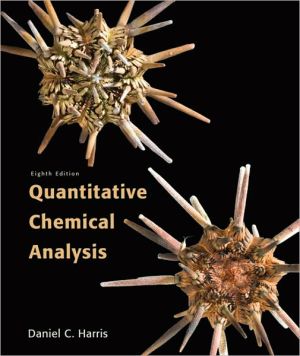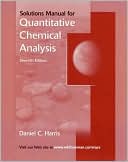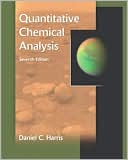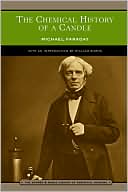Introduction to Semimicro Qualitative Analysis
Semimicro Qualitative Analysis, Eighth Edition, addresses two important current issues in chemistry education: the need for students to acquire a knowledge of descriptive chemistry and a growing interest by teaching chemists to expose students to the concepts of "green chemistry."\ Although descriptive chemistry may be difficult to define precisely, most chemists would agree that a major component of this subject—descriptive chemistry—is the chemistry of the more common elements and their...
Search in google:
This self-teaching lab manual presents a process for learning descriptive chemistry in the format of a scheme of analysis. Readers are challenged to call upon their manipulative and observational skills to provide the basis for identifying a substance or a mixture of substances.Describes the strategy of qualitative analysis so that readers have a review of the principles readily available when they are engaged in the details of laboratory work. Presents the concepts involved in qualitative analysis, systematically dealing with the nature of the chemical compounds. Features well-tested analytical procedures. Provides an early introduction to the principles of “green chemistry.” Includes a list of required equipment and a list of all reagents used with directions for preparing all solutions.A self-teaching manual useful for anyone who wants to learn more about chemistry in the laboratory.
The subject of qualitative analysis has its roots in the works of Boyle (1627-1691) who, some argue, laid the foundations for the subject by using flame colors, spot tests, "fumes," precipitates, specific gravity, and solvent action as analytical tools. The modern expression of qualitative analysis can be traced directly to Fresenius (1818-1897) whose thesis, published in 1842, was the basis for a successful student manual on qualitative analysis. This manual was revised repeatedly to keep the subject up to date as chemistry passed through a phase of uncertain notation and nomenclature and experienced the reforms instigated by Cannizzaro's use of Avogadro's hypothesis to clarify a number of apparently troublesome facts, and which clarified the "nature of the molecule." An American edition, translated by S.W. Johnson, appeared in 1869.\ The current interest in the need for students to "learn some descriptive chemistry" can be satisfied by a course in qualitative analysis. Although "descriptive chemistry" may be difficult to define precisely, most chemists would agree that a major component of this subject is the chemistry of the more common elements and their compounds. From this point of view, the chemistry of elements and their compounds is probably best expressed as the chemical processes that occur in an aqueous environment—processes that involve considerations of metathetical, redox, and complexation reactions, namely, the directions in which these processes occur (thermodynamics) as well as how rapidly they occur (kinetics).\ This kind of practical descriptive chemistry can be, and has been, discussed on the printed page, but we believe it is best learned by the student in a laboratory setting. We choose to use, as the basis of descriptive chemistry, the chemistry of the compounds of common metal canons formed with a relatively small number of anions. The focus of this kind of chemistry is qualitative analysis, a format that most students find engaging and informative. The basis for our analysis scheme is the relative solubilities of the chlorides, sulfides, and hydroxides of a representative selection of canons. Thus, we present a process for learning descriptive chemistry in the format of a scheme of analysis where students are challenged to bring to bear their manipulative and observational skills to provide the basis for identifying a substance or a mixture of substances. In our experience, most students enjoy the "hunt" for the unknown. We recognize the fact that wet methods of qualitative analysis are not usually used in modern chemical laboratories; the scheme of analysis presented here is designed as a method of learning descriptive chemistry, not necessarily of providing a practical modern scheme of analysis.\ The interest in exposing our students early to the principles of "green chemistry"—using less chemicals and smaller volumes of solution in a benign solvent—is also met by providing them with an experience in the semimicro methods of qualitative analysis, which is the focus of the experimental processes described here.\ The experimental procedures outlined here are in consonance with the current "less-than-macro" trends in laboratory instruction. All the benefits of this strategy—small quantities of chemicals involved, simpler equipment, fewer hazards—accrue from the use of the semimicro methods of qualitative analysis described.\ The chapters in this edition are distributed into three parts. In Part I, we describe the strategy of qualitative analysis. We believe it is pedagogically beneficial for students to have a review of the principles readily available when they are engaged in the details of laboratory work. Accordingly, in Part II, we present the concepts involved in qualitative analysis; systematically dealing with the nature of chemical compounds, including ionic, covalent, and coordination compounds, and the chemical reactions they undergo, stressing solution processes and equilibria. The discussion in Part II is intended to support the practical aspects of qualitative analysis that appear in Part III. The well-tested analytical procedures of Part III from previous editions remain, for the most part, intact. Within each chapter of Part III is a general survey of the chemistry of the species in a qualitative analysis group of ions, followed by the experimental details for the ions in that group.\ We have attempted to direct the reader's attention to certain important sections of Part III by using the following pictorial devices.\ An exclamation point symbol indicates a cautionary section, that is, a place in the directions where a safety problem could arise if the procedure is not followed carefully.\ A key symbol indicates a key idea, a place in the directions where a principle described in Part II is applied. The reader would benefit from recognizing the relationship of the principle to the action being described at the key symbol.\ We express our appreciation to users of previous editions, colleagues, and students for suggestions, comments, and criticisms, which were helpful in preparing this revision. We would also like to thank the following reviewers for their suggestions: Gerhard Buchbauer of the University of Vienna, Philip W Crawford of Southeast Missouri State University, Lisa C. Price of Bennett College, and Duanne E. Weisshaar of Augustana College. For invaluable assistance in the preparation of the manuscript for this edition, we express great appreciation to Rita D. Wilkinson. The editorial staff at Prentice Hall are gratefully acknowledged for their extensive contributions to the production of this volume.\ J.J.L.\ Austin, Texas\ Note to instructors\ After a short overview of the strategy of qualitative analysis in Part I, we intend Part II, the theory of qualitative analysis, to be a review of the important principles of chemistry that pertain to the laboratory-oriented phenomena that are normally associated with qualitative analysis as described in Part III. Many of the questions at the end of the chapters in Part III serve to illustrate the principles developed in Part II. Conversely, the problems at the end of the chapters in Part II anticipate some of the more practical problems listed in Part III.\ A list of the required equipment appears in Appendix III. We find it useful to most students to be introduced to each piece of equipment and special technique at the time it is first used in the plan of analysis described here. The equipment is of the standard semimicro type available at most supply houses. Only a few items need to be prepared, but these can be made by the student. If H2S gas is used as a precipitating reagent, the student will need to prepare several hydrogen sulfide bubbling tubes from 6-mm glass tubing, as shown in Fig. 10.2 and described in the accompanying text. If each student is to prepare H2S by heating a mixture of sulfur, paraffin, and asbestos, simple generators of the type illustrated in Fig. 10.2 must be set up. Stirring rods will need to be cut from 3-mm glass rods and fire-polished.\ A list of all reagents used with directions for preparing all solutions is also given in Appendix III.\ The experimental procedures and specific tests have been checked numerous times; if the directions given are followed with care, good results will be obtained. We would appreciate being informed of errors, inconsistencies, or ambiguities in the procedures.\ In general, net equations are used to describe reactions that occur in solution in conformity with the principle that equations should indicate the predominant species in the system. No effort has been made to present the detailed mechanisms of the more complex reactions.
CONTENTSPart I GENERAL STRATEGY 1 The Strategy of Qualitative Analysis SummaryPart II CONCEPTS IN QUALITATIVE ANALYSIS 2 The Nature of Chemical Reactions KineticsChemical EquilibriumThermodynamicsSummary3 The Nature of Chemical CompoundsPhysical Properties of CompoundsClassification of Chemical compoundsThe Ionization of WaterAcids and Bases4 Solution PhenomenaConcentration UnitsSolubilityEquilibrium Processes Involving Sparingly Soluble Ionic SubstancesColloidal dispersions5 Complex CompoundsLewis Theory of Chemical CombinationsNomenclatureTheoretical ConsiderationsStability of Complex IonsThe Role of Complex Ions in Qualitative Analysis6 Oxidation–Reduction ReactionsPart III THE PRACTICE OF QUALITATIVE ANALYSIS 7 The Practical Aspects of Qualitative Analysis The Periodic TableChemical ReactionsEquilibrium ConsiderationsFormation of PrecipitatesDissolving PrecipitatesLaboratory Safety8 Laboratory PracticesSummary of Laboratory WorkRecord of Laboratory Work and Laboratory ReportsLaboratory Procedures9 The Silver GroupThe Chemistry of the Silver Group IonsPrecipitation and Analysis of the Silver GroupSeparation of Lead from Silver and Mercury (I)Separation and Detection of Silver and Mercury10 The Copper-Arsenic GroupThe Chemistry of the Copper-Arsenic Group IonsSeparation of the Copper Subgroup from the Arsenic SubgroupSeparation of Mercury from Lead, Bismuth, Copper, and CadmiumSeparation of Lead from Bismuth, Copper, and CadmiumSeparation of Bismuth from Copper and CadmiumDetection of Copper and CadmiumSeparation of Arsenic from Antimony and Tin11 The Aluminum-Nickel GroupThe chemistry of the Aluminum-Nickel Group IonsPrecipitation and Analysis of the Aluminum-Nickel GroupSeparation of the Aluminum Subgroup from the Nickel SubgroupDetection of Iron, Cobalt, Nickel, and Manganese12 The Barium-Magnesium GroupThe Chemistry of the Barium-Magnesium Group IonsDetection of Ammonium SaltsThe Separation and Detection of BariumThe Separation and Detection of CalciumDetection of Sodium and Potassium13 The Analysis of Alloys14 Analysis of Salts and Salt MixturesExamination of the SolidSolubility of the SaltReactions with Specific ReagentsPreliminary ExperimentsAnalysis of Unknown SaltExamination of the SolidDissolution of the SolidDetermine What Cations Are PresentTreatment of the Unknown with Class ReagentsSpecific Tests for Anions15 Recording and Reporting AnalysisAPPENDICESI Brief Review of Oxidation NumbersII Solution of Quadratic EquationsIII Reagents and Equipment UsedIndex of ProceduresIndex








